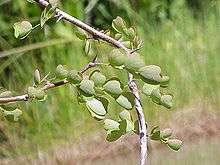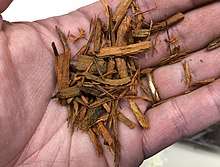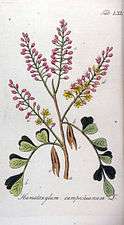Haematoxylum campechianum
Haematoxylum campechianum (blackwood, bloodwood tree, bluewood, campeachy tree, campeachy wood, campeche logwood, campeche wood, Jamaica wood, logwood or logwood tree)[2] is a species of flowering tree in the legume family, Fabaceae, that is native to southern Mexico, the Caribbean, and northern Central America.[3] The tree was of great economic importance from the 17th century to the 19th century, when it was commonly logged and exported to Europe for use in dyeing fabrics.[4] The modern nation of Belize developed from 17th- and 18th-century logging camps established by the English. The tree's scientific name means "bloodwood" (haima being Greek for blood and xylon for wood).
| Haematoxylum campechianum | |
|---|---|
 | |
| Scientific classification | |
| Kingdom: | Plantae |
| Clade: | Tracheophytes |
| Clade: | Angiosperms |
| Clade: | Eudicots |
| Clade: | Rosids |
| Order: | Fabales |
| Family: | Fabaceae |
| Subfamily: | Caesalpinioideae |
| Tribe: | Caesalpinieae |
| Genus: | Haematoxylum |
| Species: | H. campechianum |
| Binomial name | |
| Haematoxylum campechianum L., 1753 | |
| Synonyms | |
| |
Uses
Haematoxylum campechianum was used for a long time as a natural source of dye.[5] The woodchips are still used as an important source of haematoxylin, which is used in histology for staining.[5] The bark and leaves are also used in various medical applications. In its time, it was considered a versatile dye, and was widely used on textiles and also for paper.[6]
The extract was once used as a pH indicator. Brownish when neutral, it becomes yellow-reddish under acidic conditions and purple when alkaline.[6] In a small demonstrative experiment, if two drops, one of concentrated ammonia and one of logwood extract, are placed close enough, the NH3 vapours will change the color of the extract to a purple shade.[7]

Logwood and pirates
Logwood also played an important role in the lives of 17th-century buccaneers and into the Golden Age of Piracy. Spain claimed all of Central and South America as its sovereign territory through the 17th and 18th centuries; despite this, English, Dutch, and French sailors recognized the value of logwood and set up camps to cut and collect the trees for shipment back to Europe. Spain periodically sent privateers to capture the logwood cutters – for example, Juan Corso's 1680 cruise – sometimes in retaliation for buccaneer raids on Spanish cities.[8] Logwood cutters, now out of work, frequently joined onto pirate and buccaneer crews to raid the Spanish in return, as Edmund Cooke did after losing two logwood-hauling ships to the Spanish.[9] When Spanish forces ejected a great many logwood cutters in 1715, they flocked to Nassau and swelled the already-considerable numbers of pirates gathering there.[10] By the mid-1720s logwood cutters had themselves become targets of pirates such as Francis Spriggs, Edward Low, and George Lowther;[11] pirate captains Samuel Bellamy and Blackbeard went further, turning captured logwood-hauling sloops into pirate vessels.[12] Logwood cutting was profitable – "According to a government report, in the four years 1713 to 1716, some 4,965 tons of logwood were exported to England at not less than £60,000 per annum" – but only brought in a fraction of the profits from tobacco and other legal exports, and "was always a minor industry carried on by a few hundred ex-seamen and pirates in a remote corner of the globe".[13]
Gallery
References
- Bachman, S. (2020). "Haematoxylum campechianum". IUCN Red List of Threatened Species. 2020: e.T62026169A174152099. Retrieved 11 August 2020.
- Umberto Quattrocchi (2012). CRC World Dictionary of Medicinal and Poisonous Plants. Common Names, Scientific Names, Eponyms, Synonyms and Etymology (5 Volume Set). Boca Raton: CRC Press, Taylor & Francis Group. p. 1919. ISBN 9781420080445.
- "Haematoxylum campechianum". Germplasm Resources Information Network (GRIN). Agricultural Research Service (ARS), United States Department of Agriculture (USDA). Retrieved 2009-01-27.
- Hofenk de Graff, Judith H. (2004). The Colourful Past: Origins, Chemistry and Identification of Natural Dyestuffs. London: Archetype Books. p. 235. ISBN 1873132131.
- Ortiz-Hidalgo C, Pina-Oviedo S (2019). "Hematoxylin: Mesoamerica's Gift to Histopathology. Palo de Campeche (Logwood Tree), Pirates' Most Desired Treasure, and Irreplaceable Tissue Stain". Int J Surg Pathol. 27 (1): 4–14. doi:10.1177/1066896918787652. PMID 30001639.
- Hammeke, Erin (2004). "Logwood Dye on Paper" (PDF). University of Texas at Austin. Retrieved 2008-07-05.
- Chemical Recreations, John Joseph Griffin, 1834, p. 279
- Latimer, Jon (2009). Buccaneers of the Caribbean: How Piracy Forged an Empire. Cambridge, MA: Harvard University Press. p. 225. ISBN 9780674034037. Retrieved 12 December 2018.
- Marley, David (2012). Daily Life of Pirates. Santa Barbara, CA: ABC-CLIO. pp. 51, 79–82, 180. ISBN 9780313395635. Retrieved 12 January 2018.
- Sanders, Richard (2007). If a pirate I must be: the true story of Bartholomew Roberts, king of the Caribbean. London: Aurum. Retrieved 18 September 2017.
- Snow, Edward Rowe (1944). Pirates and buccaneers of the Atlantic coast. Boston MA: Boston, Yankee Pub. Co. Retrieved 13 December 2018.
- Woodard, Colin (2008). The Republic of Pirates: Being the True and Surprising Story of the Caribbean Pirates and the Man Who Brought Them Down. Orlando FL: Houghton Mifflin Harcourt. ISBN 9780547415758. Retrieved 13 December 2018.
- Cordingly, David (2013). Under the Black Flag: The Romance and the Reality of Life Among the Pirates. New York: Random House Publishing Group. ISBN 9780307763075. Retrieved 28 July 2017.



